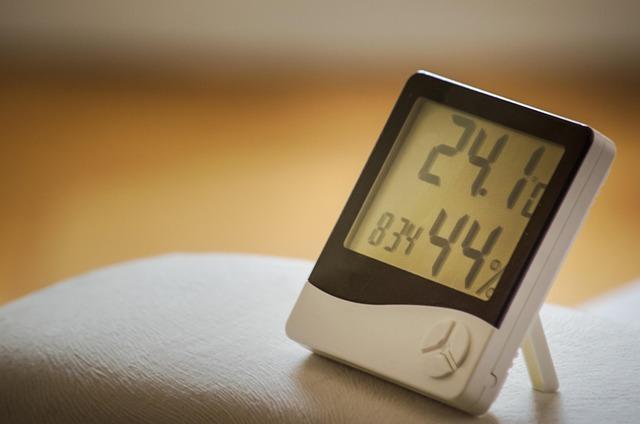As the summer sun beats down and the air becomes thick with moisture, many homeowners find themselves battling unwelcome humidity within their walls. High humidity levels can lead to discomfort, mold growth, and damage to your home’s interiors. Fortunately, there are several effective strategies to reclaim comfort from the clutches of damp air. From utilizing exhaust fans to investing in hygrometers, this article will explore practical and efficient methods to lower the humidity in your house, ensuring a healthier living environment year-round. Discover how simple adjustments to your home can significantly enhance your indoor air quality and overall well-being.
Understanding Humidity and Its Impact on Your Home
Humidity plays a crucial role in the comfort and sustainability of your living environment. High moisture levels can lead to a variety of issues, including mold growth, structural damage, and indoor air quality problems. To maintain a healthy balance, it is essential to understand the optimal humidity range, typically between 30% and 50%. When humidity exceeds this range, the air feels heavy and can create an ideal breeding ground for allergens and pests. Therefore, managing humidity is not just about discomfort; it directly impacts your home’s integrity and your family’s health.
To effectively lower humidity levels in your house, consider implementing several practical strategies:
- Use a Dehumidifier: This appliance efficiently removes excess moisture from the air, making it a vital tool in high-humidity areas.
- Ventilation: Ensure proper airflow throughout your home by utilizing exhaust fans in bathrooms and kitchens. Open windows when weather permits to facilitate fresh air circulation.
- Seal Leaks: Inspect and seal any gaps or cracks around windows and doors where moist air may enter.
- Humidity Sensors: Install devices that can monitor and alert you to changes in humidity, allowing for timely adjustments to your home’s environment.
Identifying Signs of Excess Humidity Indoors
Recognizing the presence of excess humidity in your living space is essential for maintaining a healthy environment. One of the most noticeable signs is the growth of mold and mildew, which can appear as dark spots on walls, ceilings, or even furniture. This fungal growth thrives in damp conditions and not only damages surfaces but can also pose serious health risks. Additionally, you may start to notice musty odors lingering in the air, a telltale sign of hidden moisture problems. Look for signs of condensation on windows and walls, especially during cooler months, as this can indicate high humidity levels.
Physical discomfort is another indicator of excessive moisture indoors. If you often feel sticky, experience difficulty breathing, or notice your allergies worsening, these could be effects of elevated humidity. Pay attention to your home’s furnishings; wooden items may warp or swell, and paint may peel or bubble. Other subtle clues include water stains on walls or ceilings and feeling a persistent chill even when the thermostat seems normal. Identifying these signs early can help you address humidity issues promptly, safeguarding both your home and health.
Examining the Common Causes of High Humidity Levels
High humidity levels can arise from several factors that often go unnoticed in our daily routines. One of the primary culprits is poor ventilation within the home. Insufficient air circulation can trap moisture indoors, especially in areas like kitchens and bathrooms where steam is frequently generated. Other common causes include:
- Weather conditions: Warm, humid climates naturally lead to higher indoor humidity.
- Leaks and water damage: Hidden leaks in plumbing or roofing can introduce excess moisture.
- Household activities: Activities such as cooking, showering, and drying laundry indoors add significant moisture to the air.
Additionally, the use of certain heating systems can exacerbate humidity problems. For example, radiators can emit steam, and certain types of air conditioning units may not sufficiently remove humidity from the air. Furthermore, having a large number of houseplants can contribute to elevated humidity levels due to their transpiration process. Addressing these issues often requires a multi-faceted approach, focusing on identifying sources of moisture and improving airflow to create a more balanced indoor environment.
Embracing Natural Ventilation for Improved Airflow
Natural ventilation offers an effective solution for enhancing airflow and reducing humidity levels within your home. By leveraging the natural forces of wind and temperature differences, you can create a comfortable indoor environment without relying on mechanical systems. The key to optimizing this passive strategy lies in strategically placing windows, vents, and doors to facilitate cross-ventilation. This approach not only circulates air but also helps to use the cool outdoor breezes to lower indoor temperatures, thereby diminishing humidity levels.
To fully embrace natural ventilation, consider implementing the following strategies:
- Open Windows and Doors: Allow fresh air to flow through your home by opening windows and doors during cooler parts of the day.
- Utilize Ventilation Shafts: Design ventilation pathways in your home to enhance the movement of air.
- Incorporate Overhangs: Use shaded areas to promote airflow while protecting against direct sunlight and rain.
By adopting these techniques, you’ll not only improve the overall air quality in your home but also create a more pleasant living environment that feels refreshing and invigorating.
Utilizing Dehumidifiers: Choosing the Right Model
When selecting a dehumidifier for your home, it’s essential to consider several factors that align with your specific needs. Start by evaluating the size of the area you intend to dehumidify, as different models are designed for varying room sizes. Look for units capable of handling the following capacities:
- Portable dehumidifiers: Ideal for smaller spaces like bathrooms or laundry rooms.
- Whole-house models: Best for large living areas or basements that require extensive moisture control.
Another crucial aspect is the energy efficiency of the dehumidifier. Models with the Energy Star certification can significantly reduce your electricity costs while maintaining optimal performance. Additionally, pay attention to features such as humidity controls, auto-shutoff, and filter systems, which can enhance convenience and improve air quality. read customer reviews and compare warranties to ensure that you’re investing in a reliable unit that will serve your home effectively for years to come.
Exploring the Role of Air Conditioning in Humidity Control
The effectiveness of air conditioning systems extends beyond mere temperature control, playing a crucial role in managing indoor humidity levels. When air conditioning units operate, they do not just cool the air; they also remove moisture as part of the cooling process. This function is vital for creating a comfortable living space, particularly in humid climates where excessive moisture can lead to discomfort, mold growth, and damage to furnishings. When the air is cooled, its capacity to hold moisture decreases, resulting in condensation that is drained away, effectively lowering the humidity inside the home. Key benefits of air conditioning in humidity control include:
- Improved comfort levels throughout the home.
- Reduction in allergens, such as dust mites and mold.
- Protection of structural integrity and furnishings from moisture-related damage.
In addition to basic cooling, modern air conditioning systems often incorporate dehumidifying features that enhance their humidity control capabilities. Many units now offer settings that allow homeowners to specifically target humidity levels without excessively lowering the temperature, providing a balanced indoor environment. This advanced functionality not only creates a more pleasant atmosphere but also supports energy efficiency, as maintaining optimal humidity levels can reduce the need for excessive cooling. To maximize the efficacy of an air conditioning system in managing humidity, regular maintenance is essential, ensuring filters and drainage systems are clean and functioning properly. Consider these tips for effective humidity control:
- Schedule routine maintenance for your air conditioning unit.
- Utilize programmable thermostats to manage humidity levels effectively.
- Avoid over-cooling the space, which can lead to discomfort.
Incorporating Houseplants That Help Reduce Humidity
One of the most natural and aesthetically pleasing methods to lower indoor humidity levels is by incorporating specific houseplants that naturally absorb moisture from the air. These green companions not only improve air quality but also enhance the decor of your living space. Some of the most effective plants that can help manage humidity include:
- Boston Fern: Its lush fronds work tirelessly to extract excess moisture, making it a fantastic humidity regulator.
- Spider Plant: Known for its air-purifying qualities, this hardy plant also draws in humidity while being easy to care for.
- Pothos: This resilient vine loves a humid environment, but it can absorb excess moisture to create a balanced atmosphere.
- Areca Palm: A popular choice for indoor landscaping, this palm actively lowers humidity levels, offering a tropical feel.
In addition to absorbing humidity, these plants can also regulate temperature and contribute to a relaxed, serene environment. By strategically placing them in areas where humidity tends to rise — like the bathroom or kitchen — you can maximize their benefits. Combine these plants with other humidity-lowering tactics, such as enhancing ventilation and using dehumidifiers, for a well-rounded approach to creating a comfortable indoor climate.
Sealing Leaks and Insulating for Better Humidity Management
To effectively manage humidity levels in your home, one of the critical steps involves sealing leaks that can allow excess moisture to enter your living spaces. Begin by inspecting areas around doors and windows where air might leak through. Common strategies include:
- Applying weather stripping to gaps around windows and doors
- Using caulk to seal cracks or crevices in walls and foundations
- Installing door sweeps to reduce airflow beneath exterior doors
Alongside sealing leaks, enhancing insulation plays a vital role in maintaining a stable indoor environment. Excellent insulation not only keeps your home at a comfortable temperature but also prevents moisture buildup. Consider these approaches to improve your insulation:
- Adding insulation to attics and crawl spaces to deter condensation
- Using moisture-resistant materials in areas prone to dampness, like basements
- Reassessing insulation in exterior walls to limit outdoor humidity from affecting indoor air
Adjusting Your Home’s Heating Practices for Optimal Comfort
To achieve the perfect balance between heat and humidity, consider investing in a *dehumidifier*, a device specifically designed to tackle excess moisture in the air. By operating this appliance consistently, especially during the more humid months, you can effectively lower indoor humidity levels without compromising warmth. Additionally, ensuring proper ventilation in your home is crucial; explore using exhaust fans in kitchens and bathrooms to eliminate steam and moisture generated by daily activities. A well-ventilated space not only enhances comfort but also supports the longevity of your home’s structure.
Another effective strategy involves using your heating system wisely. *Programmable thermostats* can help regulate both temperature and humidity levels, maintaining a comfortable environment without unnecessary energy expenditure. Incorporating moisture-absorbing materials like *desiccants* or placing potted plants that prefer drier conditions can further contribute to a more balanced atmosphere. Remember, small adjustments in your home ecosystem can lead to a significant improvement in overall comfort, allowing you to enjoy a cozy living space year-round.
Implementing Smart Home Technology for Humidity Monitoring
Integrating smart home technology for humidity monitoring in your living space can lead to significant improvements in comfort and air quality. By utilizing smart humidity sensors, homeowners can easily track the moisture levels in various rooms and receive real-time alerts on their smartphones. These sensors not only provide accurate readings but can also link with other devices such as smart thermostats and dehumidifiers to create a cohesive environment. With the ability to set up automation, you can programme your dehumidifier to activate when the humidity surpasses a certain threshold, ensuring optimal conditions without manual intervention.
To maximize the benefits of smart humidity monitoring, consider implementing a network of interconnected devices that enhance control and monitoring capabilities. Here are some key components to include:
- Smart Humidistats: These devices provide precise humidity readings and can control other devices based on the data collected.
- Smart Dehumidifiers: Units that can be controlled remotely and automatically adjust their operation based on humidity levels detected by your smart sensors.
- HVAC Integration: Smart thermostats that monitor humidity can optimize heating and cooling systems to improve overall efficiency.
- Alerts and Notifications: Set up alerts for when humidity levels reach uncomfortable levels, allowing for immediate action.
By leveraging these smart devices, you can maintain a balanced and healthy indoor environment, ultimately lowering humidity levels and enhancing your home’s livability.
Developing a Consistent Maintenance Routine for Long-Term Solutions
Establishing a reliable maintenance routine is essential for effectively managing humidity levels in your home over time. This routine should include regular inspections and adjustments to your existing humidity control systems, such as humidifiers and dehumidifiers. Consider the following strategies:
- Schedule monthly checks on your humidifier and dehumidifier to ensure they are functioning optimally and replacing filters as needed.
- Monitor humidity levels using a hygrometer to track changes and adjust settings accordingly.
- Inspect insulation and ventilation in critical areas like bathrooms and kitchens, where humidity is often generated.
In addition to equipment maintenance, adopting daily habits can significantly contribute to lowering indoor humidity. Simple adjustments in daily routines can prevent excessive moisture buildup. Incorporate these practices into your lifestyle:
- Utilize exhaust fans while cooking and showering to vent humid air outside.
- Air out your home by opening windows on drier days to allow fresh air to circulate.
- Limit indoor plant watering and use methods such as air drying clothes outdoors to reduce moisture released into the air.
In Conclusion
As we draw the curtains on our exploration of humidity control, it’s clear that maintaining a balanced environment in your home is not just about comfort—it’s about health and well-being. By implementing the strategies discussed, you can transform dampness into dryness, creating a space where you can breathe easy and live freely.
Whether you choose to invest in dehumidifiers, enhance ventilation, or incorporate plant life that thrives in drier conditions, each step you take is a step towards a healthier home. Remember, the journey to lowering humidity is a continuous one, requiring attention and adaptation. As seasons change and climates shift, keep your home dynamic and responsive.
In your quest for a more comfortable living space, know that simple changes can lead to substantial improvements. Let each drop of excess moisture be a reminder that you hold the power to create a sanctuary, free from the clutches of humidity. As you navigate this path, embrace the knowledge and the tools at your disposal, and bring forth a refreshing transformation to your home. Here’s to clearer air and brighter days ahead!




